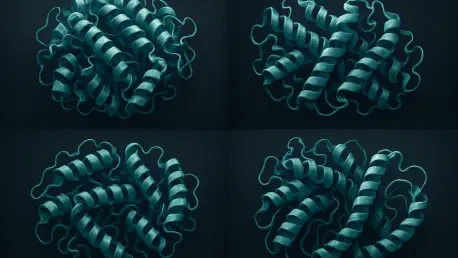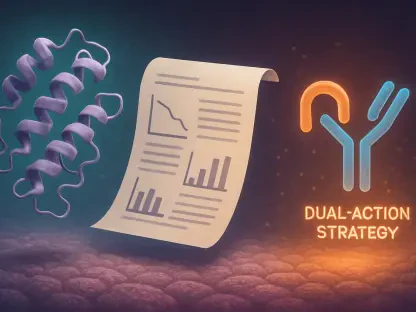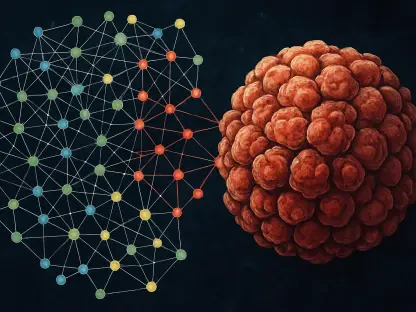In a stunning turn of events, a transformative study has shattered long-standing assumptions about the fragility of proteins, revealing them to be far more resilient than the scientific community ever imagined, fundamentally changing our understanding of biological structures. Published in Science, this research from the Centre for Genomic Regulation (CRG) in Barcelona and the Wellcome Sanger Institute flips the script on how proteins are understood to function and evolve. For decades, the prevailing view painted proteins as delicate structures, where even a minor mutation could lead to catastrophic collapse, much like pulling a critical piece from a Jenga tower. Yet, this groundbreaking work suggests a different analogy—proteins are more akin to sturdy Lego blocks, capable of withstanding significant alterations without losing their integrity. This revelation not only reshapes fundamental biological concepts but also paves the way for revolutionary advancements in fields like medicine and bioengineering, promising a future where protein design is more precise and efficient.
Redefining Protein Durability
The notion that proteins are inherently fragile has been a cornerstone of biological thought for years, but this new research challenges that foundation with compelling evidence. By focusing on the S### domain, a small but vital component of signaling proteins, the study demonstrates that the core of a protein can tolerate substantial mutations without unraveling. This resilience stems from a remarkable ability to adapt—when one part of the structure is altered, other regions can adjust to maintain overall stability. Such findings indicate that nature has far greater flexibility in experimenting with protein designs than previously assumed. This shift in understanding suggests that evolutionary processes have been less constrained, allowing for a broader range of protein sequences to emerge over billions of years without sacrificing functionality.
Delving deeper into this adaptability, the research highlights how compensatory mechanisms play a crucial role in protein endurance. Unlike the old view of proteins as precarious systems where a single change could spell disaster, the study shows that mutations in the core are often balanced by stabilizing changes elsewhere. This dynamic interplay means that diversity in protein structures isn’t necessarily a liability but can be a source of strength. The implications are profound, as this resilience challenges scientists to rethink how proteins have evolved across species. It opens up new avenues for exploring how life has adapted to countless environmental pressures, suggesting that what was once seen as a risky mutation might actually contribute to biological innovation and survival.
Harnessing Technology for Protein Insights
One of the most striking aspects of this study is its innovative use of technology to decode the mysteries of protein stability. By integrating high-throughput experimental techniques with advanced machine learning, researchers have developed a predictive model that can accurately determine which protein variants will remain stable, even when tested across vastly different organisms like bacteria and humans. This isn’t mere speculation; the model is grounded in extensive data, revealing that the biochemical principles governing protein folding have remained remarkably consistent throughout evolutionary history. Such predictive capability marks a significant leap forward, providing a reliable tool for scientists to anticipate protein behavior with unprecedented precision.
Beyond the theoretical impact, this technological breakthrough offers a new lens through which to view biological systems. The ability to forecast stability across species underscores the universal nature of protein folding rules, suggesting that these principles are not just a quirk of specific organisms but a fundamental aspect of life itself. This finding allows researchers to approach protein studies with a broader perspective, confident that insights gained from one species might apply to others. Moreover, the machine learning model serves as a bridge between raw data and actionable knowledge, streamlining the process of identifying stable protein sequences. As this technology continues to evolve, it could become an indispensable asset in unraveling the complexities of protein dynamics, setting the stage for discoveries that were once thought impossible.
Transforming Medicine and Industry
The practical implications of this research are nothing short of revolutionary, particularly in the realms of drug development and bioengineering. Traditional methods of protein engineering, often reliant on tedious and costly trial-and-error processes, can now be transformed by this predictive approach. By forecasting the outcomes of multiple simultaneous mutations, the new model drastically reduces the time and expense involved in designing stable proteins for therapeutic use. For instance, creating proteins that evade immune responses—a process known as protein resurfacing—becomes far more efficient, potentially leading to more effective treatments for a range of conditions with fewer side effects.
Equally exciting is the potential impact on industrial applications, where engineered proteins play a vital role in processes like enzyme production. The ability to rapidly design proteins that are both stable and functional could accelerate innovation in sectors ranging from pharmaceuticals to sustainable manufacturing. Consider the possibility of crafting enzymes that operate under extreme conditions or antibodies that target diseases with pinpoint accuracy—all achievable at a fraction of the current cost and timeline. This research not only promises to enhance the efficiency of existing technologies but also inspires the development of novel solutions to pressing global challenges. The ripple effects of these advancements could reshape how industries approach biological design, making what was once a slow grind into a streamlined endeavor.
Charting the Future of Protein Science
Looking ahead, the trajectory of this research points to an ambitious expansion of its scope and impact. Plans are already underway to apply this predictive framework to other protein domains, using data from representative examples to model entire protein families. This scalability suggests a future where the design of biological systems could occur at an industrial pace, fundamentally altering the landscape of scientific innovation. The ability to generalize findings across diverse protein types would enable researchers to tackle complex challenges with a level of speed and confidence previously unattainable, pushing the boundaries of what can be achieved in both academic and applied settings.
Reflecting on the strides made, it’s evident that this study has laid a robust foundation for rethinking protein stability in recent years. The shift from viewing proteins as fragile entities to recognizing their inherent toughness was a pivotal moment, driven by meticulous experimentation and cutting-edge computational tools. As those efforts culminated in a deeper understanding of evolutionary principles, they also delivered practical tools that reshaped drug discovery and bioengineering. Moving forward, the focus should be on leveraging these insights to explore uncharted protein territories, ensuring that the momentum of this discovery continues to drive progress. Expanding access to such predictive models and fostering collaboration across disciplines will be key steps in unlocking the full potential of this transformative era in biological science.









